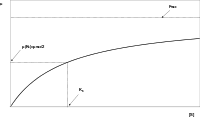Monod equation
The Monod equation is a mathematical model for the growth of microorganisms. It is named for Jacques Monod who proposed using an equation of this form to relate microbial growth rates in an aqueous environment to the concentration of a limiting nutrient.[1][2][3] The Monod equation has the same form as the Michaelis–Menten equation, but differs in that it is empirical while the latter is based on theoretical considerations.
The Monod equation is commonly used in environmental engineering. For example, it is used in the activated sludge model for sewage treatment.
Equation
The Monod equation is:[4]

where:
- μ is the specific growth rate of the microorganisms
- μmax is the maximum specific growth rate of the microorganisms
- S is the concentration of the limiting substrate for growth
- Ks is the "half-velocity constant"—the value of S when μ/μmax = 0.5
μmax and Ks are empirical coefficients to the Monod equation. They will differ between species and based on the ambient environmental conditions.
Application notes
The rate of substrate utilization is related to the specific growth rate as follows:[5]
- rsu = −μX/Y
where:
- X is the total biomass (since the specific growth rate, μ is normalized to the total biomass)
- Y is the yield coefficient
rsu is negative by convention.
In some applications, multiple terms of the form [S/(Ks + S)] are multiplied together where more than one nutrient or growth factor has the potential to be limiting (e.g. organic matter and oxygen are both necessary to Heterotrophic bacteria).
Graphical determination of constants
As with the Michaelis–Menten equation graphical methods may be used to fit the coefficients of the Monod equation:[6]
See also
- Activated sludge model (uses the Monod equation to model bacterial growth and substrate utilization)
- Michaelis–Menten kinetics
- Jacques Monod
References
- ↑ Jacques Monod. 1949. The Growth of Bacterial Cultures. Annual Review of Microbiology, v. 3, p. 371.
- ↑ Monod, J. 1942. Recherches sur la croissance des Cultures Bactériennes. Hermann. Paris
- ↑ Dochain, D. 1986. On-line parameter estimation, adaptave state estimation and adaptave control of fermentation processes. Thése. Leuven University. Louvain la Neuve. Belgium
- ↑ http://www.bren.ucsb.edu/academics/courses/219/Lectures/Lecture_4_ESM219_06.ppt.pdf
- ↑ Metcalf & Eddy, Inc. 2003. Wastewater Engineering: Treatment & Reuse, 4th ed. McGraw–Hill: New York.
- ↑ http://www.bren.ucsb.edu/academics/courses/219/Lectures/Lecture_4_ESM219_06.ppt.pdf
